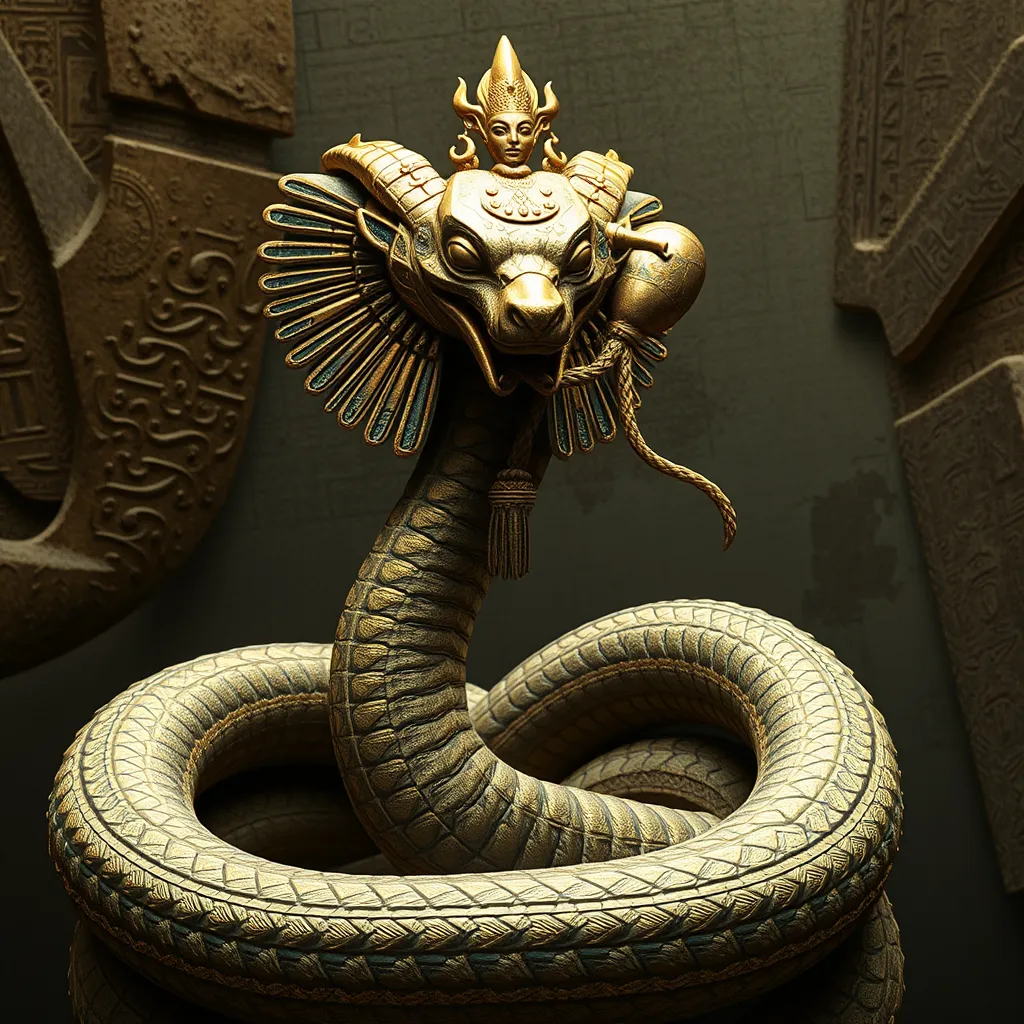The Serpent Goddess: Wadjet and Her Symbolic Significance
I. Introduction
Wadjet, often referred to as the Serpent Goddess, holds a prominent place in Ancient Egyptian mythology. Known for her protective qualities and fierce nature, she embodies the duality of life and death, showcasing the complexity of existence in ancient beliefs. Wadjet’s significance transcends her role as a deity; she represents the heart of Egyptian spirituality, intertwining with the very essence of the land and its people.
This article aims to explore the symbolic significance and cultural importance of Wadjet, delving into her historical context, iconography, protective attributes, and the duality she embodies. Through this exploration, we will uncover how Wadjet continues to influence modern interpretations and spirituality.
II. Historical Context of Wadjet
The origins of Wadjet can be traced back to the early days of Ancient Egyptian religion, where she was revered as a fierce protector. Initially, she was associated with the Nile Delta, where her imagery was prominent. As the goddess of Lower Egypt, her name translates to “the green one,” symbolizing fertility and the lush landscapes of the Nile basin.
Wadjet’s role in the pantheon of Egyptian gods and goddesses evolved over the centuries. She was often depicted alongside other deities, particularly during the unification of Upper and Lower Egypt, where she became a symbol of the pharaoh’s authority and divine protection. Her worship grew in prominence, and she was frequently invoked for safeguarding the nation.
Over time, Wadjet’s representation transformed, adapting to the changing religious landscape of Egypt. From a local deity to a key figure in the national identity, her evolution reflects the broader shifts within the Egyptian belief system.
III. Iconography and Attributes of Wadjet
Wadjet is primarily represented in serpent form, a powerful symbol in Ancient Egyptian culture. Her imagery often features a cobra, which not only signifies her protective nature but also symbolizes royalty and sovereignty. The Uraeus, a stylized representation of a cobra, adorned the crowns of pharaohs, signifying their divine right to rule and their connection to Wadjet.
In addition to the cobra, other iconographic elements associated with Wadjet include:
- The ankh, symbolizing life
- The sistrum, a musical instrument linked to fertility and joy
- The sun disk, representing the solar deity Ra and her role in the cosmic order
Artistic depictions of Wadjet can be found in temples, tombs, and various artifacts, where she is often portrayed as a woman with a serpent on her head or in full serpent form, ready to protect those who honor her.
IV. Wadjet as a Protector and Guardian
As a protector of Egypt and the pharaoh, Wadjet’s role was pivotal in both warfare and governance. She was revered as a fierce guardian, often depicted in battle scenes where her presence was believed to ensure victory. The symbolism of her protective qualities extends beyond the battlefield; she was also seen as a guardian of law and order, embodying the principles of Ma’at, or cosmic balance.
Rituals and practices honoring Wadjet were commonplace in ancient Egypt. These included:
- Offering prayers and sacrifices at temples dedicated to her
- Creating amulets bearing her likeness for protection
- Participating in festivals celebrating her attributes and powers
Through these rituals, the ancient Egyptians sought her favor and protection in their daily lives, reinforcing her significance in both the spiritual and political realms.
V. The Duality of Wadjet: Life and Death
Wadjet’s symbolism encompasses both life-giving and death-related aspects. She is intricately linked to the Nile, which provided sustenance and fertility to the land. The waters of the Nile, blessed by her presence, were seen as a source of life, enabling agriculture and civilization to flourish.
Conversely, Wadjet also had connections to the afterlife. As a protector of the dead, she was believed to guide souls through the journey of death, ensuring safe passage and protection from malevolent forces. This duality highlights the balance between creation and destruction inherent in her symbolism, embodying the cyclical nature of life.
VI. Wadjet in Myth and Legend
Numerous stories and myths surround Wadjet, showcasing her origin and powers. One such myth describes her emergence from the tears of the sun god Ra, emphasizing her divine nature and connection to the cosmos. Her fierce protection of the pharaohs in battle stories further illustrates her vital role in Egyptian mythology.
Comparisons can be drawn between Wadjet and other serpent deities across cultures, such as the Mesopotamian goddess Tiamat or the Hindu goddess Naga. These serpent figures often embody similar themes of protection, fertility, and the balance of life and death, underscoring a universal archetype found in many mythologies.
The significance of Wadjet’s myths lies in their reflection of Ancient Egyptian beliefs, offering insights into how the people understood their world and the forces that governed it.
VII. Modern Interpretations and Cultural Impact
In contemporary society, Wadjet’s influence persists in various forms of spirituality and symbolism. Many modern spiritual practitioners draw inspiration from her qualities as a protector and guardian, incorporating her imagery into rituals and practices aimed at invoking strength and safeguarding against negativity.
The representation of Wadjet can also be seen in modern art, literature, and media. Artists and writers have reimagined her symbolism, exploring themes of femininity, power, and the natural world. This resurgence of interest in ancient deities highlights a growing appreciation for the wisdom embedded in these mythologies.
VIII. Conclusion
Wadjet’s symbolic significance in both ancient and modern contexts is profound. As the Serpent Goddess, she embodies the duality of life and death, protection and destruction, weaving together the fabric of Egyptian mythology. Her legacy continues to resonate today, reminding us of the importance of understanding and preserving ancient mythologies and their teachings.
In reflecting on Wadjet’s enduring impact, we recognize the value of these narratives in shaping our cultural landscape and spiritual practices. The stories of ancient deities like Wadjet not only inform our understanding of history but also inspire contemporary explorations of existence and belief.




